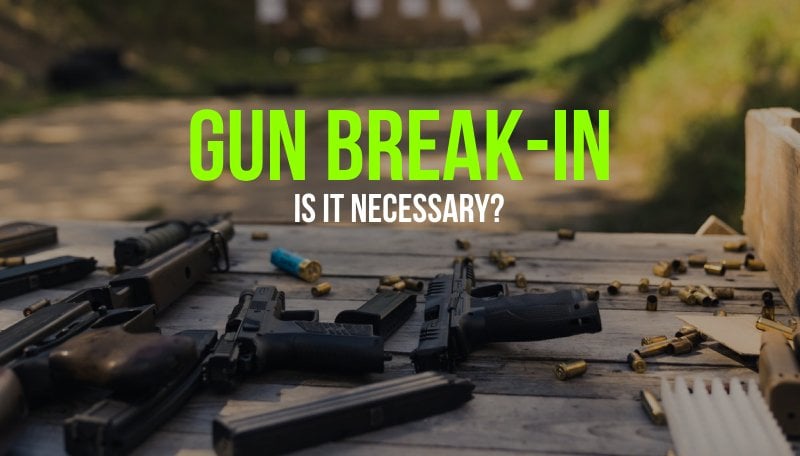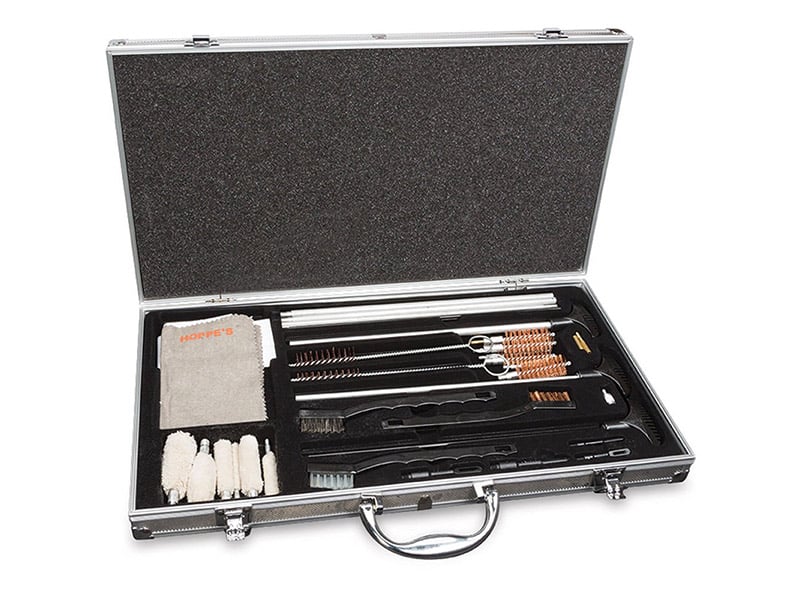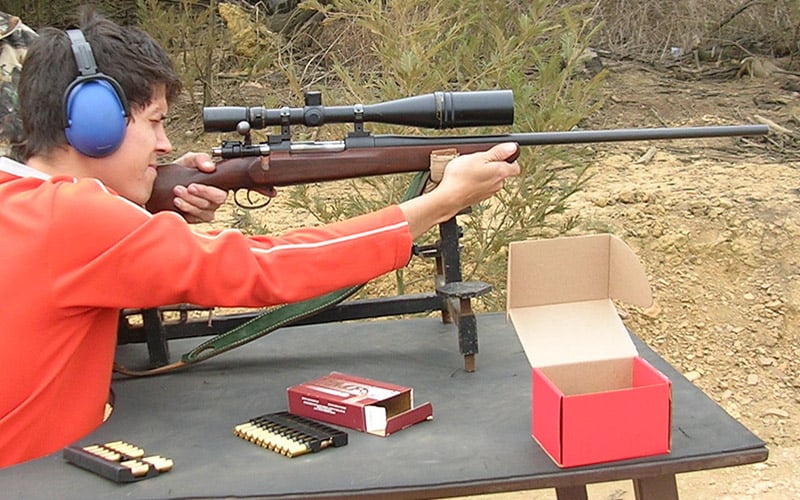
Last Updated on
Have you ever heard people saying gun break in period is a myth and that a factory gun should work properly right off the box? Well, these people have never owned a DA revolver – that’s for sure.
While many people approach or regard the break in process differently, there are some general rules everyone can follow to get the most out of their new firearm. As for whether or not it is needed, well everyone will have their own opinion, but we’ll try to arrive at a decent middle ground on the subject.
Table of Content
Do you need to break in your new gun?
Why is the initial gun cleaning and lubing important?
How to break in a rifle?
How to break in a pistol?
How to break in a shotgun?
Tips for safe gun breaking in
Gun Break In Is Real
So you’ve got a brand new firearm, and you’re excited to get out and shoot it, but does it need to be properly “broken in” before it operates at maximum efficiency? Well for one when a firearm comes off the assembly line, it is purposefully designed to be “tight” in certain elements, and if you think about it, the alternative would be undesirable. After all, you don’t want a new firearm with extremely loose parts. In addition to this factory “tightness,” most barrels are said to have microscopic portions that are slightly raised from the rest of the barrel.
So, when you allegedly begin to break in a firearm, you’re essentially gently wearing down the parts and the barrel. Your goal is to bring the firearm from “rigid” status to a happier medium. Modern firearms should work right out of the box (after an initial gun cleaning), and if they don’t, then something is likely wrong with the gun.
However, we think it’s reasonable to wonder if firearms don’t always work at their optimum level right away. Note, the optimum level does not mean operate at all, but rather it should be thought of as an extra 5% or an extra little boost when compared to the brand new gun. Of course, you shouldn’t have to worry about a break in period for high-dollar custom guns either. All said, this is where the controversial break in process comes in, and those who subscribe to it expect their firearms to perform at maximum efficiency only after firing several rounds through the gun.
Initial Gun Cleaning & Lubrication for Breaking In
There is debate as to whether a gradual firing and cleaning process matters when it comes to brxeaking in a firearm, or if you just need to fire a whole lot of rounds through it and call it good. What everyone can agree on is that every new firearm needs an initial cleaning and lubing before it is ever fired. Most firearms coming from the factory are coated with grease (a high-viscosity gun lubricant) that resists rust and ensures a long shelf life at the store or warehouse. You want any firearm you purchase to come coated like this, but as soon as you own it, you’ll want to remove it before you ever fire a shot. So the first and definitive step in any firearm break in is a thorough cleaning. Once the grease is removed, gun oil should replace it and thoroughly cover any moving parts. Now the next part is somewhat debated, but most find that a trade off of firing and cleaning is the best way to approach it.

How to Break In a Gun (by type)
Breaking in a Rifle
The rifle barrel breaking in process begins with firing a shot, cleaning the barrel, and then repeating the process for several rounds. At the beginning of this process, the bore patch should come out fairly dirty, but after a while, it shouldn’t be as gunked after each shot. After several shots and cleaning swipes, you should start cleaning after every 5-10 shots. After a couple more of those sessions, most will agree the rifle has been “safely” broken in, and you may see a slight increase in accuracy and bullet velocity as a result.
Breaking in a Pistol / Revolver
The break in of a handgun is somewhat similar, but the amount of rounds fired before cleaning varies a bit. Some will fire a single round out of the handgun and then clean the barrel to start, while others will fire a magazine or cylinder worth of rounds before cleaning the handgun. Either way, the firing and cleaning process should be repeated a couple of times, and then the frequency of rounds fired through the gun before cleaning should be increased.
In any self-defense firearm, a break in and test period is very important, and there is no debate about that. If you’re going to trust your life with a handgun, you’ll want to run several hundred rounds through it before you can truly rely on it. Most will agree at least 200 is the right number to break in with, and this can be done with bulk ammo. However, at the end of the process, a few clips of high-quality defense rounds should be used to finalize the break in period.
Breaking in a Shotgun
Of all the primary firearm types, shotguns are generally regarded as needing the least amount or no break in period before they’re ready to perform at peak efficiency. They should still receive a thorough cleaning and disassembly before use and then thorough lubrication afterward.
Bottom Line: Gun Break In Tips
Many manufacturers include break in procedures with their firearms, and unless you’re a seasoned pro with a tried-and-true method, you’re probably best off following the manufacturer’s instructions. Other manufacturers say nothing on the subject, potentially because they believe the whole process is overblown and not as necessary as most think. They may be right, but one factor that seems wise to pay attention to is the initial build up of copper in rifle barrels. Since most agree there will be imperfections in most new barrels, it seems likely that copper could build up on these imperfections until they are worn down, and cleaning after the first shots to prevent an excess build up of copper sounds prudent. That’s why it’s so important to break in a rifle barrel.

Breaking in a handgun by firing a bunch of rounds through it also makes sense, as how else are you going to make those parts operate smoothly. And when it comes to a self-defense handgun, well you have to know it works, period. The only way to truly do that is to run a couple hundred rounds through it.
Those who object to the break in process claim that it is too expensive. It’s easy to see why some think that, especially after they’ve just spent a lot on the firearm and accessories. However, who can in their right mind claim that they wanted to buy a new firearm and not test it out thoroughly to start? So in that vein, a generous supply of ammunition should be factored into any new firearm purchase, and those buying a self-defense handgun should set aside even more money for hundreds of rounds.
Other shooters regard a break in period as “an old shooters tale.” When you think about it like that, a break in period makes sense given that firearm tooling and construction have changed over the years, and older firearms probably needed a thorough break in before they operated as the shooter preferred.
What do you think? Do Firearms really need “broken in?”
Image two and thumb courtesy of Wikimedia Commons.
FAQs
How do I break in a pistol?
Breaking in a pistol involves firing a single round or a magazine worth, then cleaning the handgun. Repeat this process several times, gradually increasing the number of rounds fired before cleaning. Most agree that firing at least 200 rounds is ideal for breaking in a pistol. This can be done with bulk ammo, but using high-quality defense rounds towards the end is advisable.
What’s the process to break in a rifle?
To break in a rifle, start by firing a shot and then cleaning the barrel. Repeat these steps for several rounds. Initially, the bore patch will be quite dirty, but it should get cleaner after each shot. After a few cycles, begin cleaning after every 5-10 shots. When you’ve repeated this process a few times, your rifle should be adequately broken in, potentially improving accuracy and bullet velocity.
How can I break in a shotgun?
Shotguns typically require minimal, if any, break-in period to reach peak performance. Nevertheless, it’s crucial to thoroughly clean and disassemble your shotgun before use, and lubricate it properly afterward.





Leave a Reply